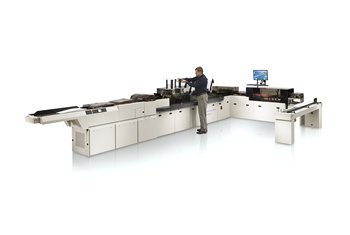FPS™ Split Drive Inserting System

| Overview | Feeders | Support |
FPS Split Drive system allows the inserter to separate document collation-assembly and the envelope insertion function processes. Each operates independently to dramatically reduce system downtime.
Benefit from reducing manual intervention
Clearing a single stoppage can be a quick effort in a perfect world. But if the operator is occupied, seconds turn to minutes and it adds up fast
No Stopping – Even with less than perfect material
Without operator intervention, the system detects and diverts faulty envelopes and re-feeds until a quality envelope is available for insertion.
The inserter quickly redirects unflapped or faulty envelopes into divert bins while continuing to run. This seamless automation ensures consistent speed and productivity, while maintaining the integrity of the mailing.
Increased Productivity Powers Maximum Output
Servo motor technology powers consistent performance to achieve new levels of system and operator productivity. The durability of this technology helps reduce unscheduled downtime and substantially extends the intervals between regularly scheduled preventative maintenance.
New View of Enhanced Performance
System monitoring is made easy with the introduction of a new top-down view at the control system. The Direct Connect Graphical User Interface (GUI) is easy to read and comes with an on-screen help and trouble shooting guide.
Benefits
- Process all your mail on one system
- Run #10 letters up to 14,000 mail pieces per hour
- Produce 6x9 letters up to 12,000 mail pieces per hour
- Finish flats mail up to 9,000 mail pieces per hour
Rotary and Friction Feeders
The FPS™ system offers both rotary and friction feeders in a modular, interchangeable design. Powered by the same APS™ servo motor technology, you get a wider range of material processing capabilities coupled with the ability for easy off-line service – increasing uptime up to 95%.
The rotary feeder offers an automated double detect feature that eliminates manual fine-tuning and alerts operators to over feeds. And easy to read error messaging translates to rapid job recovery and maximal uptime.
Rotary Feeder – Suction separation and gripper-based feeding
- Increased material flexibility – single panel glossy, stitched or glued booklets multiple coupons, chromate sheet, onion skin paper and more
- Large stack height – reduces loading frequency
- Automated setup and simplified adjustments – enhace operator efficiency
Friction Feeder – Gap separation and roller-based feeding
- Minimize jams and stoppages by optimized material separation and the synchronized placement of each enclosure
- Material flexibility to feed CDs, Z folds, business cards, stiff booklets, open ended leading inserts, credit cards and more
- Maximize performance of individual feeders with independently settable material parameters
- Ease of job setup increases operator efficiency
